Analysis of Entropy Generation in Mixed Convective Peristaltic Flow of Nanofluid
Abstract
:1. Introduction
2. Flow Modeling
Entropy Generation and Viscous Dissipation
3. Solution Methodology
3.1. Zeroth Order Systems and Solutions
3.2. First Order Systems and Solutions
4. Discussion
5. Conclusions
- Velocity profile is greater in magnitude for MWCNT (multi wall carbon nanotubes) than SWCNT (single wall carbon nanotubes).
- Entropy generation is directly related to Brinkman group parameter .
- Inverse relation exists between Bejan number and
- Enhancement in Grashof number Gr and Brinkman group parameter causes an increase in Bejan number.
- Larger values of slip parameters and enhance the size of trapped bolus but such size decreases for
- Trapped bolus size is larger for SWCNT than MWCNT.
Author Contributions
Conflicts of Interest
Nomenclature
| , − | right and left walls |
| t | Time |
| d | half width of channel |
| b | wave amplitude |
| λ | Wavelength |
| c | wave speed |
| (x, y) | Cartesian coordinates |
| (u, v) | velocity components |
| ρeff | effective density of nanofluid |
| μeff | effective viscosity of nanofluid |
| (ρC)eff | effective heat capacity of nanofluid |
| (ρβ)eff | effective thermal expansion of nanofluid |
| Keff | effective thermal conductivity |
| T0 | temperature at walls |
| p | Pressure |
| T | fluid temperature |
| g | Gravity |
| φ | nanoparticle volume fraction |
| Kf | thermal conductivity of base fluid |
| Kp | thermal conductivity of nanoparticle |
| ρf, ρp | density of fluid and nanoparticle |
| βf | fluid thermal expansion coefficient |
| βp | nanoparticle thermal expansion coefficient |
| S | stress tensor |
| 𝜏 | wall elastance parameter |
| m | mass per unit length |
| d1 | wall damping parameter |
| Cf | specific heat of fluid |
| μf | dynamic viscosity of fluid |
| Cp | specific heat of nanoparticle |
| β1 | dimensional velocity slip parameter |
| 𝛾1 | dimensional thermal slip parameter |
| Pr | Prandtl number |
| Br | Brinkman number |
| Re | Reynolds number |
| δ | wave number |
| Ec | Eckert number |
| Gr | Grashof number |
| ψ | stream function |
| E1, E2, E3, | dimensionless wall parameters |
| β | dimensionless velocity slip parameter |
| 𝛾 | dimensionless thermal slip parameter |
| Φ | viscous dissipation |
| Ɵ0 | reference temperature |
| Be | Bejan number |
| ϕm | maximum packing volume fraction |
| ϕa | effective volume fraction of aggregates |
| aa | effective radii of aggregates |
| a | radius of nanoparticles |
| D | fractal index |
References
- Choi, S.U.S. Enhancing thermal conductivity of the fluids with nanoparticles. ASME Fluids Eng. Div. 1995, 231, 99–105. [Google Scholar]
- Xue, Q. Model for thermal conductivity of carbon nanotube based composites. Phys. B Condens. Matter 2005, 368, 302–307. [Google Scholar] [CrossRef]
- Lin, Y.; Zheng, L.; Zhang, X.; Ma, L.; Chen, G. MHD pseudoplastic nanofluid unsteady flow and heat transfer in a finite thin film over stretching surface with internal heat generation. Int. J. Heat Mass Transf. 2015, 84, 903–911. [Google Scholar] [CrossRef]
- Buongiorno, J. Convective transport in nanofluids. ASME J. Heat Transf. 2006, 128, 240–250. [Google Scholar] [CrossRef]
- Sheikholeslami, M.; Ganji, D.D. Magnetohydrodynamic flow in a permeable channel filled with nanofluid. Sci. Iran. B 2014, 21, 203–212. [Google Scholar]
- Turkyilmazoglu, M. Nanofluid flow and heat transfer due to a rotating disk. Comput. Fluids 2014, 94, 139–146. [Google Scholar] [CrossRef]
- Tiwari, R.K.; Das, M.K. Heat transfer augmentation in a two-sided lid-driven differentially heated square cavity utilizing nanofluids. Int. J. Heat Mass Transf. 2007, 50, 2002–2018. [Google Scholar] [CrossRef]
- Turkyilmazoglu, M. The analytical solution of mixed convection heat transfer and fluid flow of a MHD viscoelastic fluid over a permeable stretching surface. Int. J. Mech. Sci. 2013, 77, 263–268. [Google Scholar] [CrossRef]
- Sheikholeslami, M.; Ganji, D.D.; Javed, M.Y.; Ellahi, R. Effect of thermal radiation on magnetohydrodynamics nanofluid flow and heat transfer by means of two phase model. J. Magn. Magn. Mater. 2015, 374, 36–43. [Google Scholar] [CrossRef]
- Khan, J.A.; Mustafa, M.; Hayat, T.; Alsaedi, A. Three-dimensional flow of nanofluid over a nonlinearly stretching sheet: An application to solar energy. Int. J. Heat Mass Transf. 2015, 86, 158–164. [Google Scholar] [CrossRef]
- Akram, S.; Nadeem, S. Consequence of nanofluid on peristaltic transport of a hyperbolic tangent fluid model in the occurrence of apt (tending) magnetic field. J. Magn. Magn. Mater. 2014, 358, 183–191. [Google Scholar] [CrossRef]
- Ebdid, A. Remark on the homotopy perturbation method for the peristaltic flow of Jeffrey fluid with nanoparticles in an asymmetric channel. Comput. Math. Appl. 2014, 68, 77–85. [Google Scholar] [CrossRef]
- Hayat, T.; Farooq, M.; Alsaedi, A. Stagnation point flow of carbon nanotubes over stretching cylinder with slip conditions. Open Phys. 2015, 13, 188–197. [Google Scholar] [CrossRef]
- Latham, T.W. Fluid Motion in a Peristaltic Pump. Master’s Thesis, MIT, Cambridge, MA, USA, 1966. [Google Scholar]
- Shapiro, A.H. Pumping and retrograde diffusion in peristaltic waves. In Proceedings of the Workshop in Ureteral Reflux in Children, Washington, DC, USA, 11–12 November 1967; Volume 1, pp. 109–126.
- Weinberg, S.L. Theoretical and Experimental Treatment of Peristaltic Pumping and Its Relation to Ureteral Function. Ph.D. Thesis, MIT, Cambridge, MA, USA, 1970. [Google Scholar]
- Srinivas, S.; Kothandapani, M. Peristaltic transport in an asymmetric channel with heat transfer—A note. Int. Commun. Heat Mass Transf. 2008, 35, 514–522. [Google Scholar] [CrossRef]
- Asghar, S.; Hussain, Q.; Hayat, T. Peristaltic motion of reactive viscous fluid with temperature dependent viscosity. Math. Comput. Appl. 2013, 18, 198–220. [Google Scholar]
- Mekheimer, K.S.; Elmaboud, Y.A.; Abdellateef, A.I. Particulate suspension flow induced by sinusoidal peristaltic waves through eccentric cylinders: Thread annular. Int. J. Biomath. 2013, 6, 1350026. [Google Scholar] [CrossRef]
- Hayat, T.; Rafiq, M.; Ahmad, B. Combined effects of rotation and thermal radiation on peristaltic transport of Jeffrey fluid. Int. J. Biomath. 2015, 8, 1550061. [Google Scholar] [CrossRef]
- Elmaboud, Y.A.; Mekheimer, K.S. Non-linear peristaltic transport of a second-order fluid through a porous medium. Appl. Math. Model. 2011, 35, 2695–2710. [Google Scholar] [CrossRef]
- Ramesh, K. Influence of heat and mass transfer on peristaltic flow of a couple stress fluid through porous medium in the presence of inclined magnetic field in an inclined asymmetric channel. J. Mol. Liq. 2016, 219, 256–271. [Google Scholar] [CrossRef]
- Abd-Alla, A.M.; Abo-Dahab, S.M.; Kilicman, A. Peristaltic flow of a Jeffrey fluid under the effect of radially varying magnetic field in a tube with an endoscope. J. Magn. Magn. Mater. 2015, 348, 79–86. [Google Scholar] [CrossRef]
- Sinha, A.; Shit, G.C.; Ranjit, N.K. Peristaltic transport of MHD flow and heat transfer in an asymmetric channel: Effects of variable viscosity, velocity slip and temperature jump. Alex. Eng. J. 2015, 54, 691–704. [Google Scholar] [CrossRef]
- Muthuraj, R.; Nirmala, K.; Srinivas, S. Influences of chemical reaction and wall properties on MHD peristaltic transport of a Dusty fluid with Heat and Mass transfer. Alex. Eng. J. 2016, 55, 597–611. [Google Scholar] [CrossRef]
- Hameed, M.; Khan, A.A.; Ellahi, R.; Raza, M. Study of magnetic and heat transfer on the peristaltic transport of a fractional second grade fluid in a vertical tube. Eng. Sci. Technol. Int. J. 2015, 18, 496–502. [Google Scholar] [CrossRef]
- Ellahi, R.; Hussain, F. Simultaneous effects of MHD and partial slip on peristaltic flow of Jeffrey fluid in a rectangular duct. J. Magn. Magn. Mater. 2015, 393, 284–292. [Google Scholar] [CrossRef]
- Abbasi, F.M.; Hayat, T.; Ahmad, B.; Chen, G.Q. Peristaltic motion of non-Newtonian nanofluid in an asymmetric channel. Z. Naturforsch. 2014, 69, 451–461. [Google Scholar] [CrossRef]
- Abbasi, F.M.; Hayat, T.; Ahmad, B. Impact of magnetic field on mixed convective peristaltic flow of water based nanofluids with Joule heating. Z. Naturforsch. 2015, 70, 125–132. [Google Scholar] [CrossRef]
- Abbasi, F.M.; Hayat, T.; Ahmad, B. Peristalsis of silver-water nanofluid in the presence of Hall and Ohmic heating effects: Applications in drug delivery. J. Mol. Liq. 2015, 207, 248–255. [Google Scholar] [CrossRef]
- Shehzad, S.A.; Abbasi, F.M.; Hayat, T.; Alsaadi, F. MHD mixed convective peristaltic motion of nanofluid with Joule heating and thermophoresis effects. PLoS ONE 2014, 9, e111417. [Google Scholar] [CrossRef] [PubMed]
- Hayat, T.; Abbasi, F.M.; Al-Yami, M.; Monaquel, S. Slip and Joule heating effects in mixed convection peristaltic transport of nanofluid with Soret and Dufour effects. J. Mol. Liq. 2014, 194, 93–99. [Google Scholar] [CrossRef]
- Hayat, T.; Nawaz, S.; Alsaadi, F.; Rafiq, M.; Mustafa, M. A model for an application to biomedical engineering through nanoparticles. Int. J. Heat Mass Transf. 2016, 101, 112–120. [Google Scholar] [CrossRef]
- Hayat, T.; Nawaz, S.; Alsaadi, A.; Rafiq, M. Mixed convective peristaltic flow of water based nanofluids with Joule heating and convective boundary conditions. PLoS ONE 2016, 11, e0153537. [Google Scholar] [CrossRef] [PubMed]
- Gad, N.S. Effect of Hall current on interaction of pulsatile and peristaltic induced flows of a particle-fluid suspension. Appl. Math. Comput. 2011, 217, 4313–4320. [Google Scholar] [CrossRef]
- Sheikholeslami, M.; Ganji, D.D. Entropy generation of nanofluid in presence of magnetic field using Lattice Boltzmann Method. Physics A 2015, 417, 273–286. [Google Scholar] [CrossRef]
- Akbar, N.S.; Raza, M.; Ellahi, R. Peristaltic flow with thermal conductivity of H2O + Cu nanofluid and entropy generation. Results Phys. 2015, 5, 115–124. [Google Scholar] [CrossRef]
- Abbas, M.A.; Bai, Y.; Rashidi, M.M.; Bhatti, M.M. Analysis of entropy generation in the flow of peristaltic nanofluids in channels with compliant walls. Entropy 2016, 18, 90. [Google Scholar] [CrossRef]
- Akbar, N.S.; Khan, Z.H. Entropy generation analysis for the peristaltic flow of Cu-water nanofluid with magnetic field in a lopsided channel. J. Appl. Fluid Mech. 2016, 9, 205–213. [Google Scholar]
- Akbar, N.S. Entropy generation analysis for a CNT suspension nanofluid in plumb duct with peristalsis. Entropy 2015, 17, 1411–1424. [Google Scholar] [CrossRef]
- Halefadl, S.; Estelle, P.; Aladag, B.; Doner, N.; Mare, T. Viscosity of carbon nanotubes water based nanofluids: Influence of concentration and temperature. Int. J. Therm. Sci. 2013, 71, 111–117. [Google Scholar] [CrossRef] [Green Version]
- Jung, H.M.; Um, S. Thermo-electrical properties of composite semiconductor thin films composed of nanocrystalline grapheme-vanadium oxides. J. Nanosci. Nanotechnol. 2014, 14, 9051–9059. [Google Scholar] [CrossRef] [PubMed]
- Kim, D.J.; Nam, S.Y. Characterization of sulfonated silica nanocomposite electrolyte membranes for fuel cell. J. Nanosci. Nanotechnol. 2014, 14, 8961–8963. [Google Scholar] [CrossRef] [PubMed]
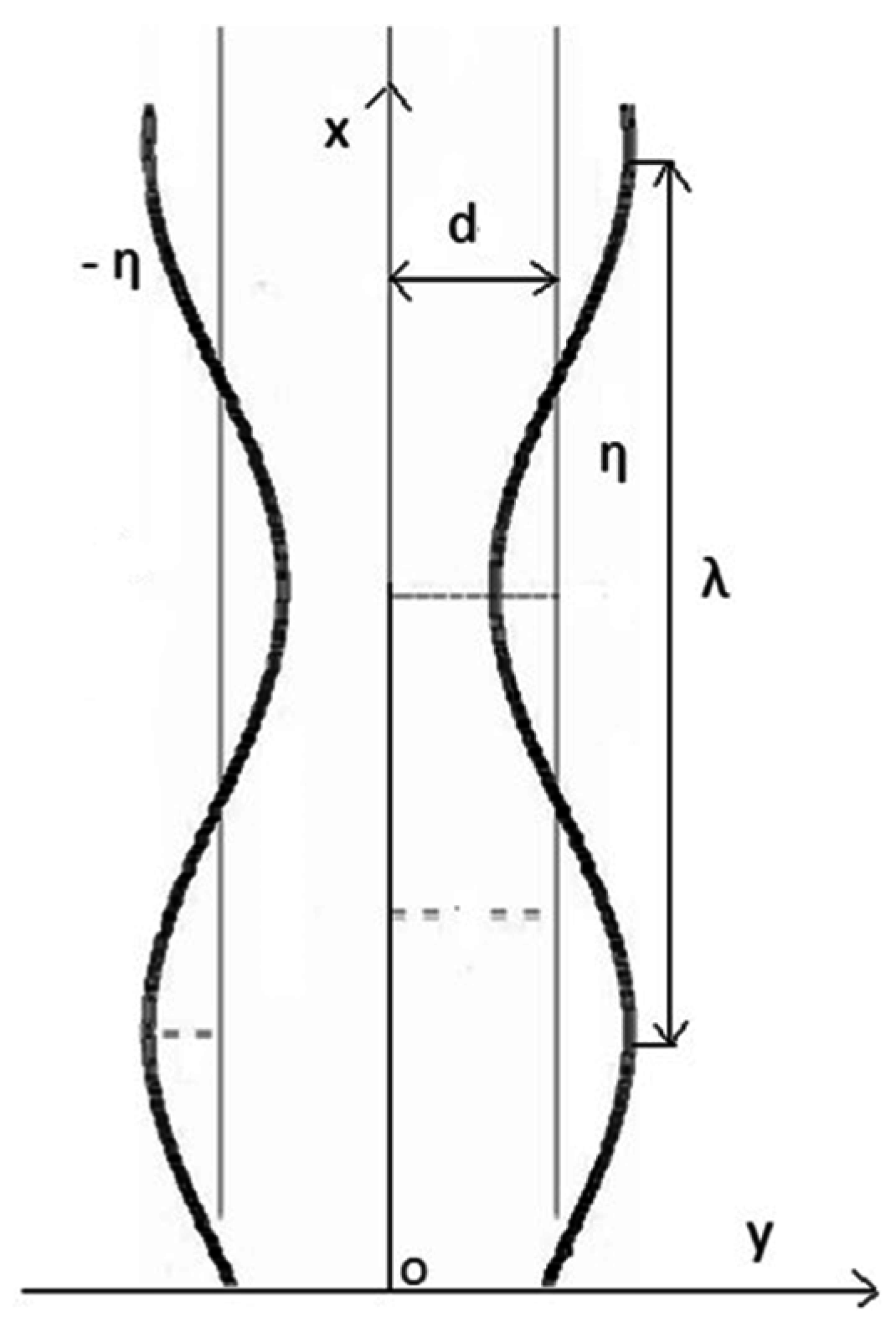
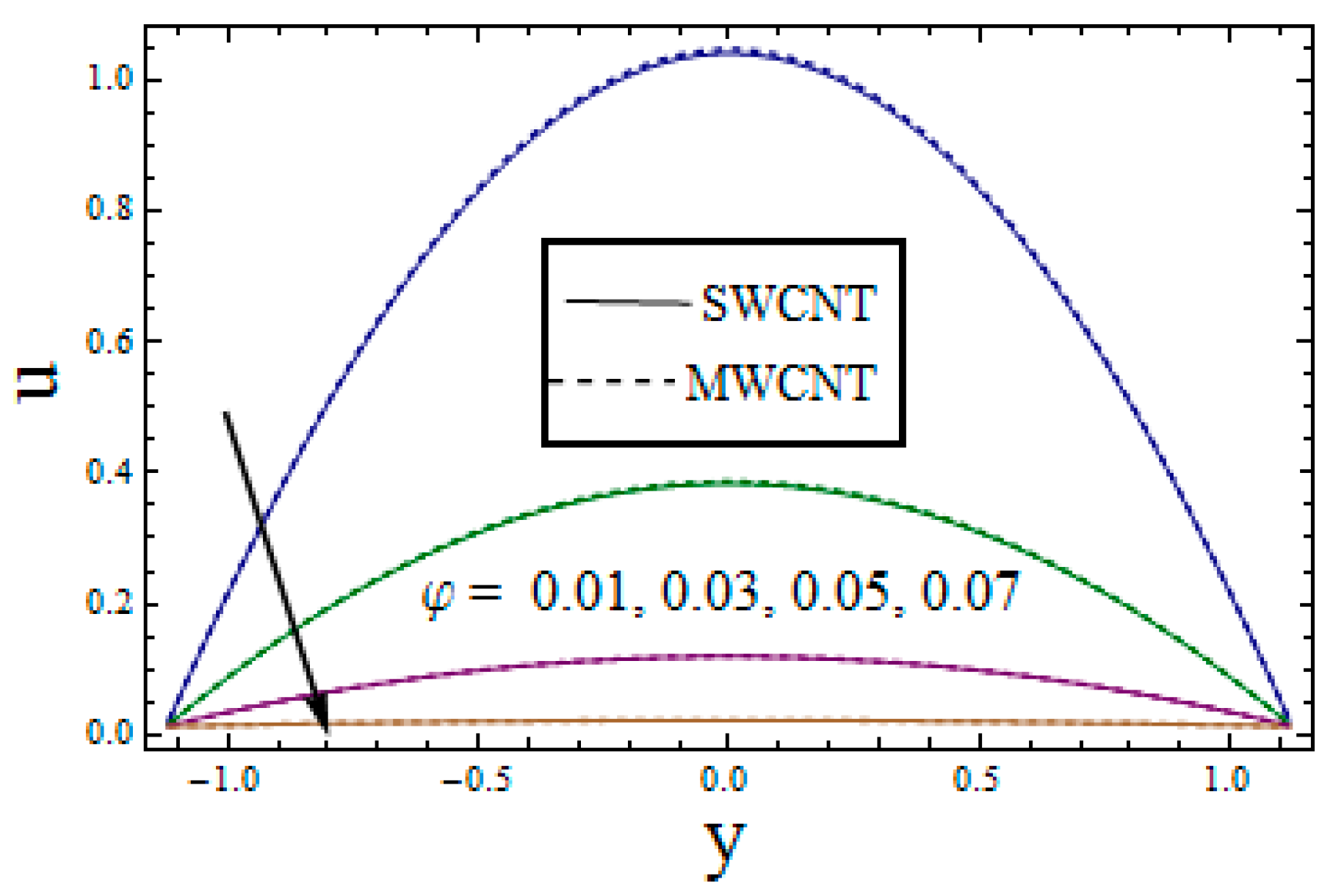
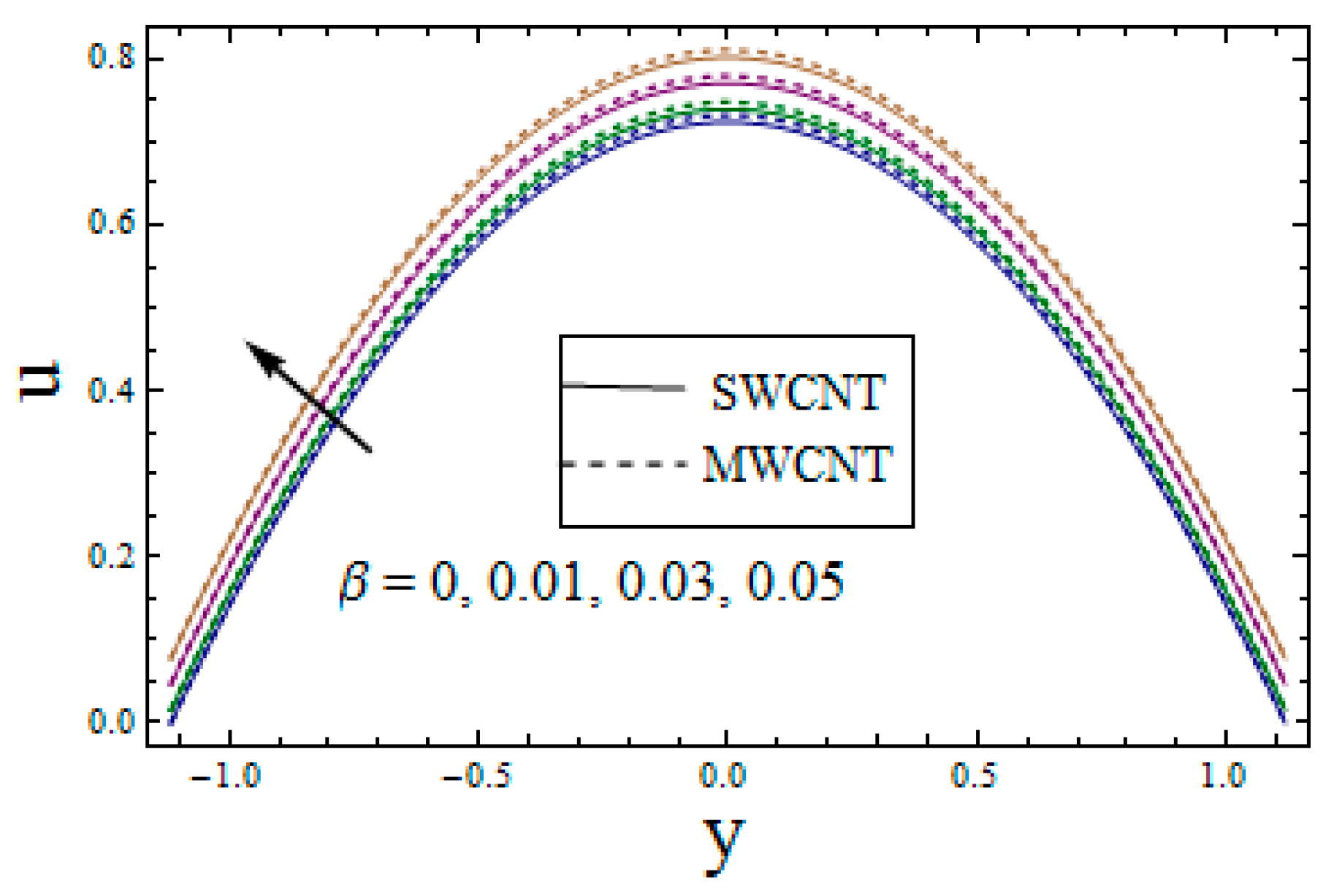
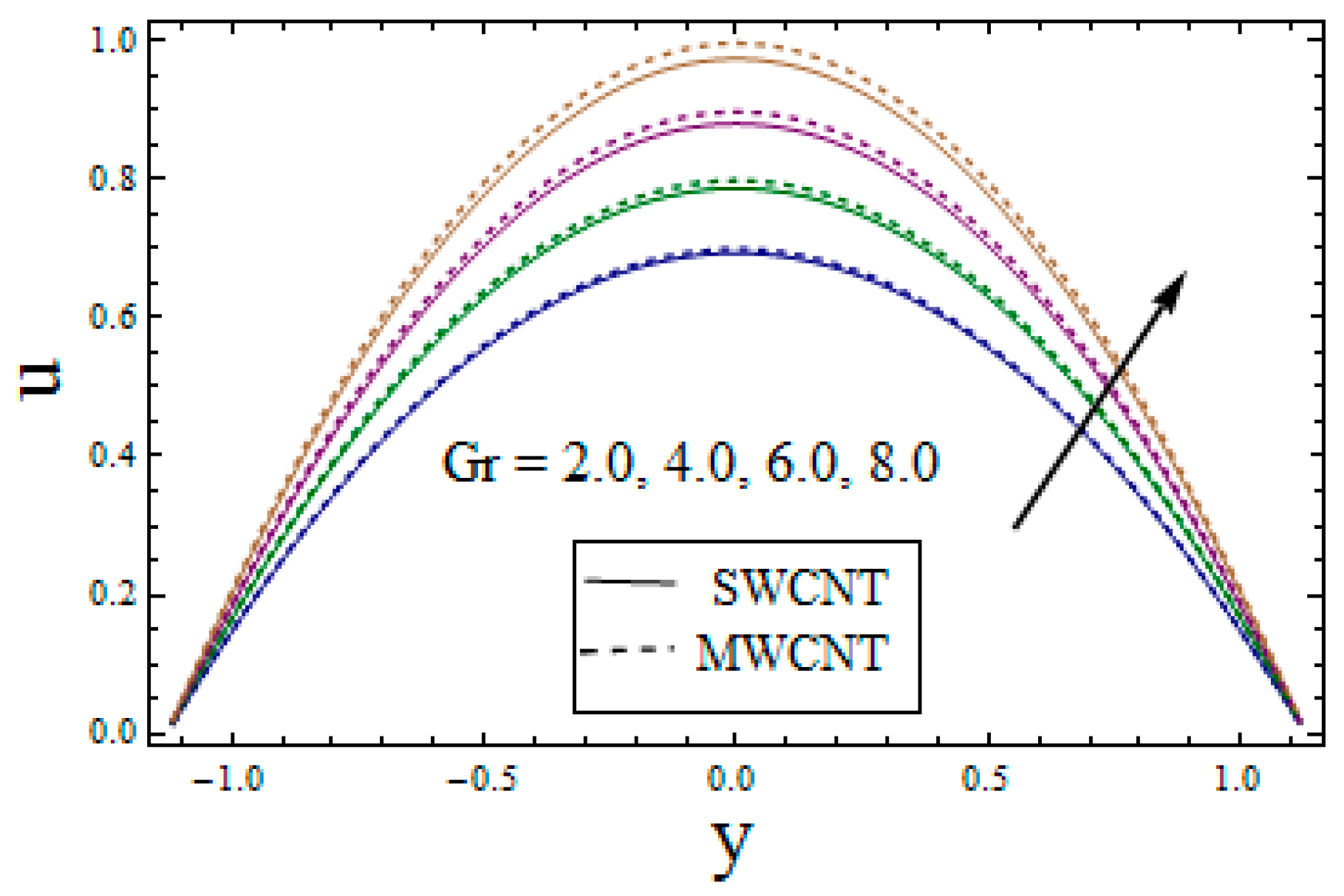

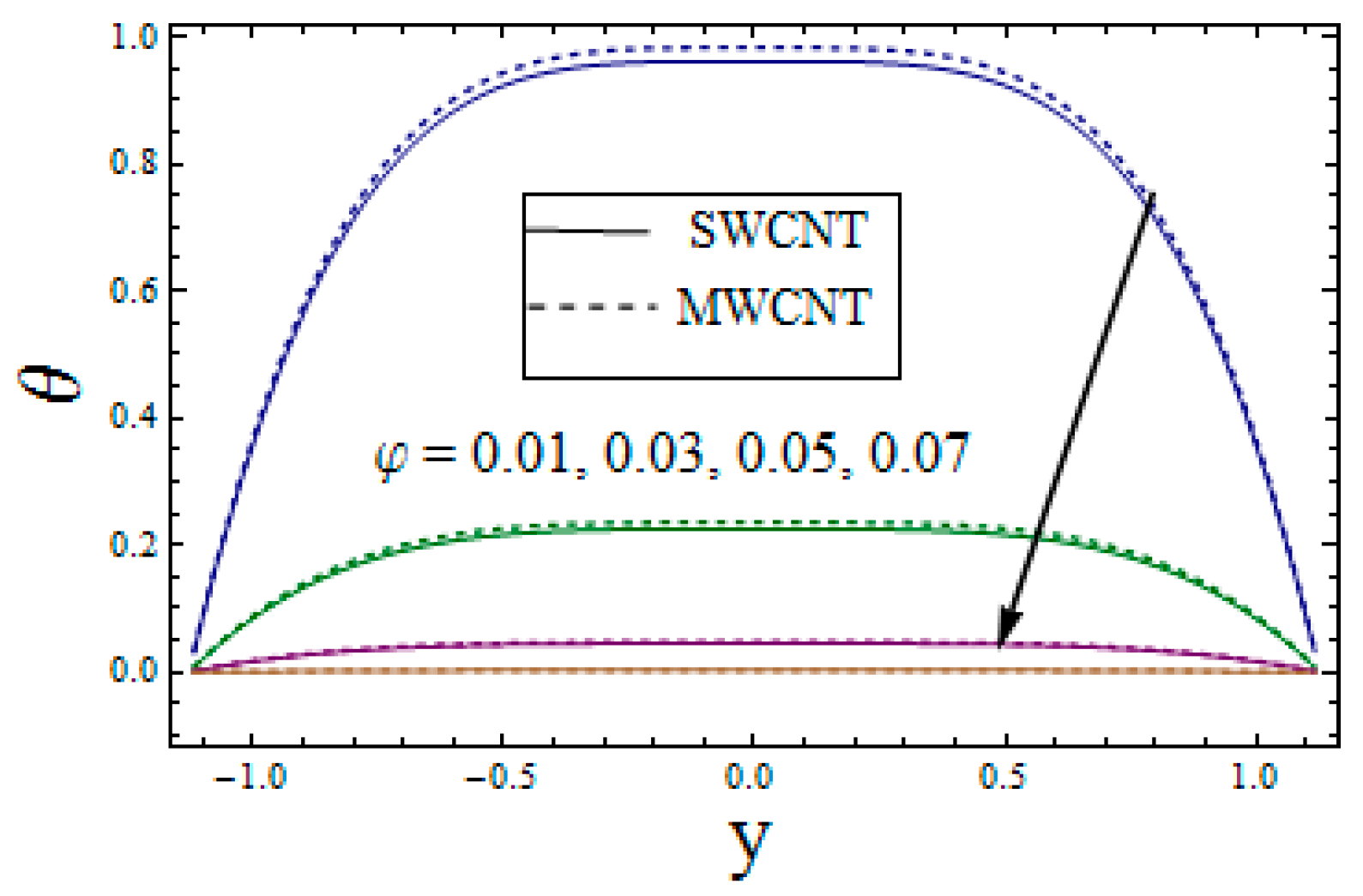
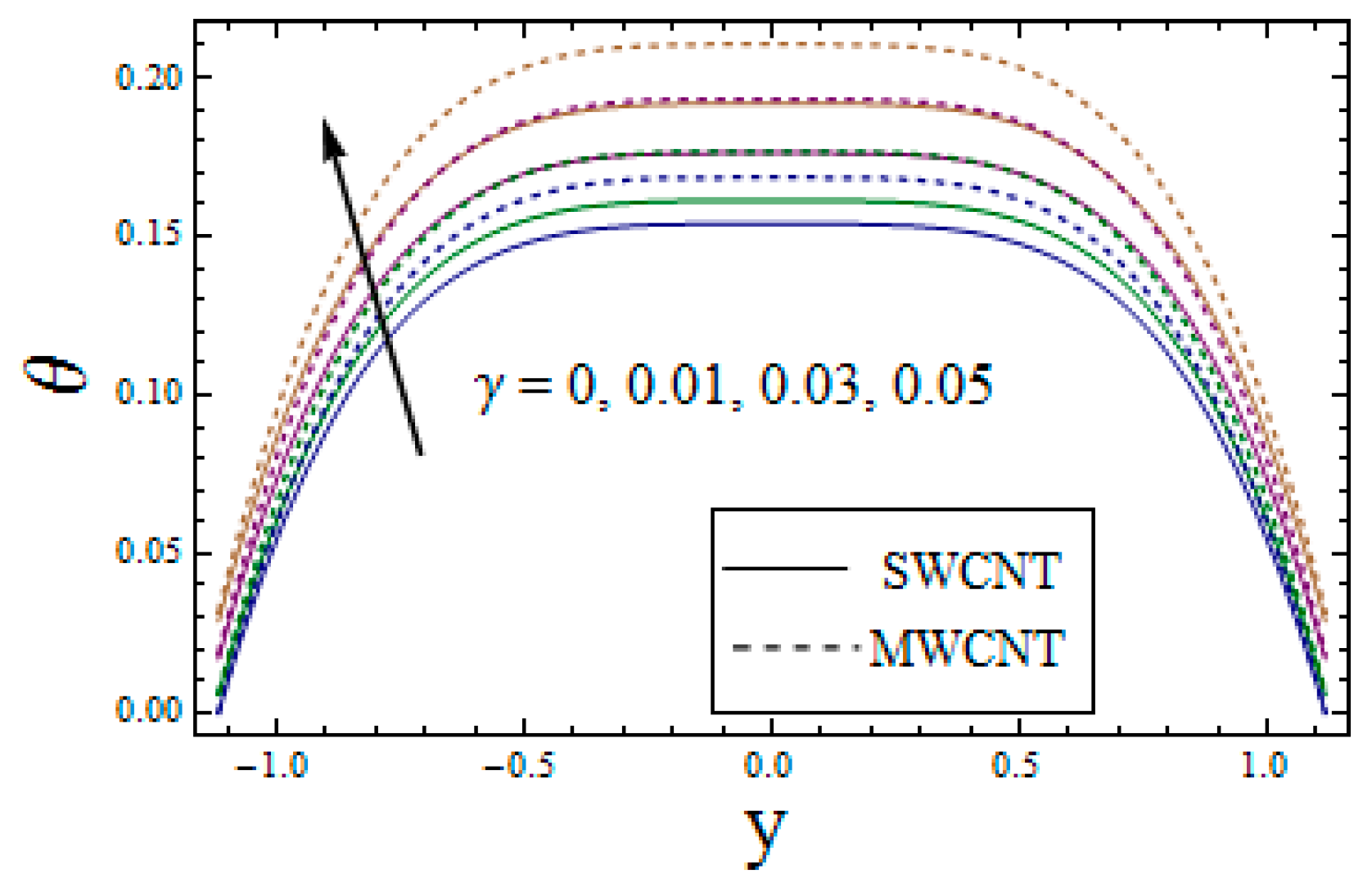
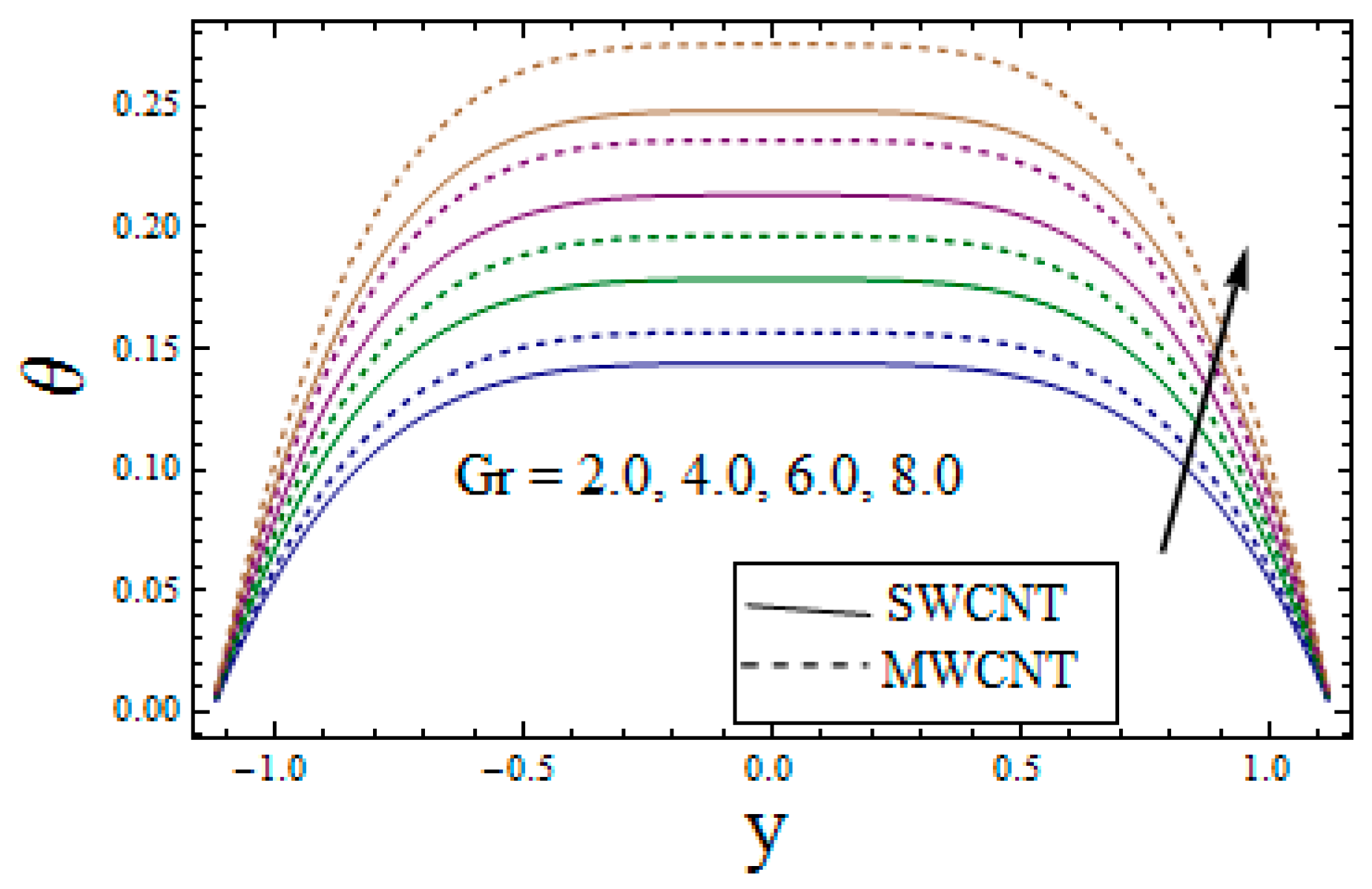
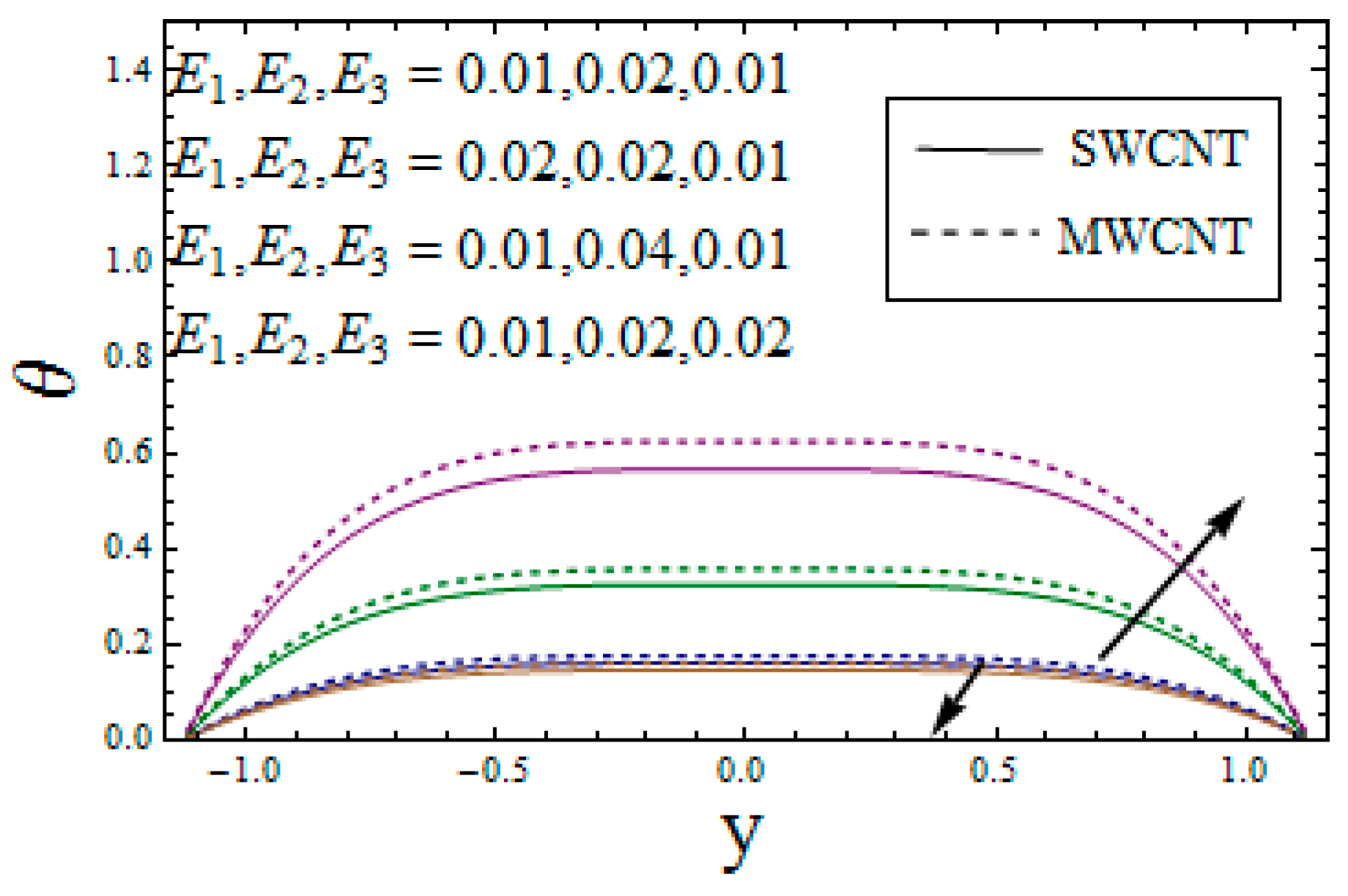
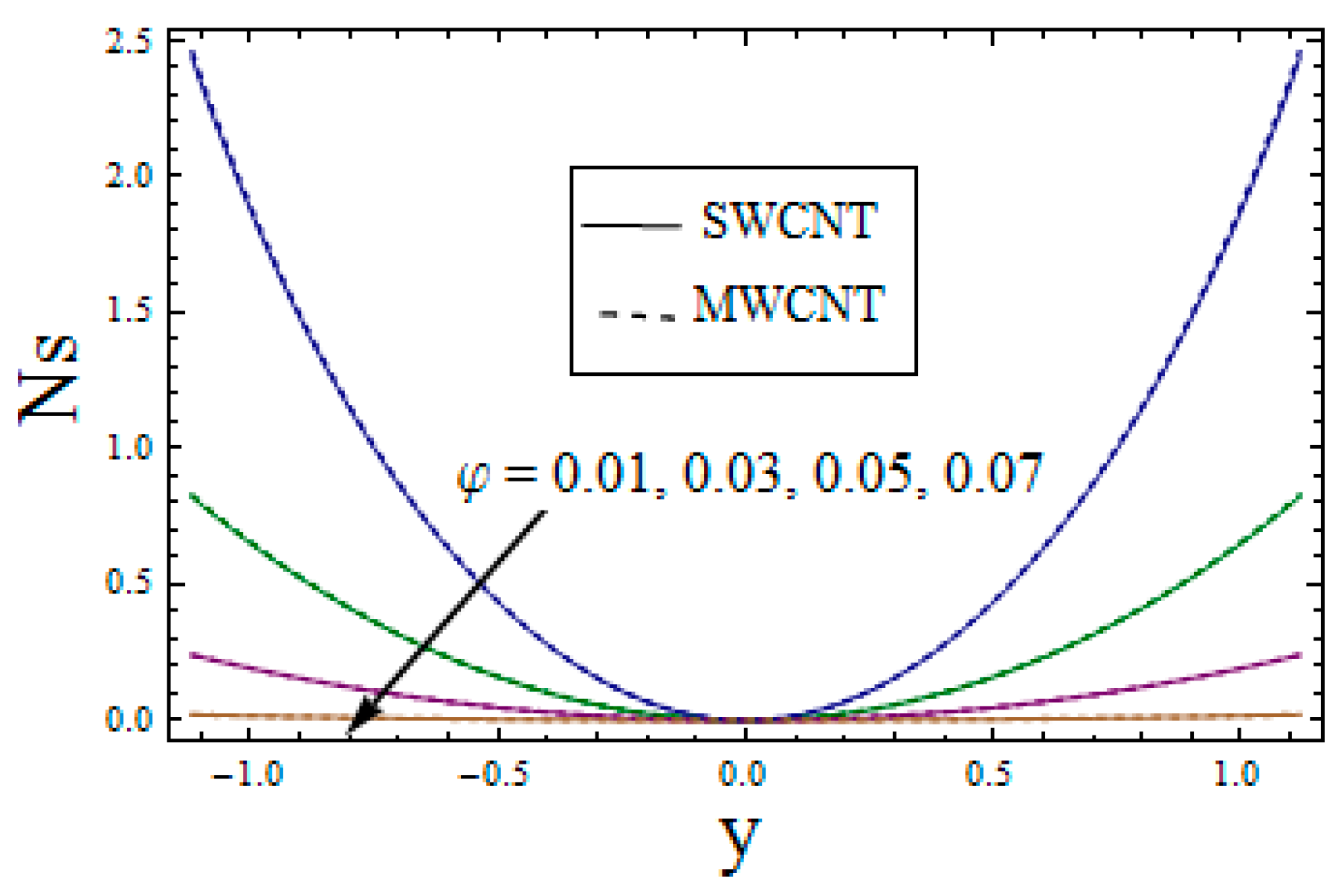
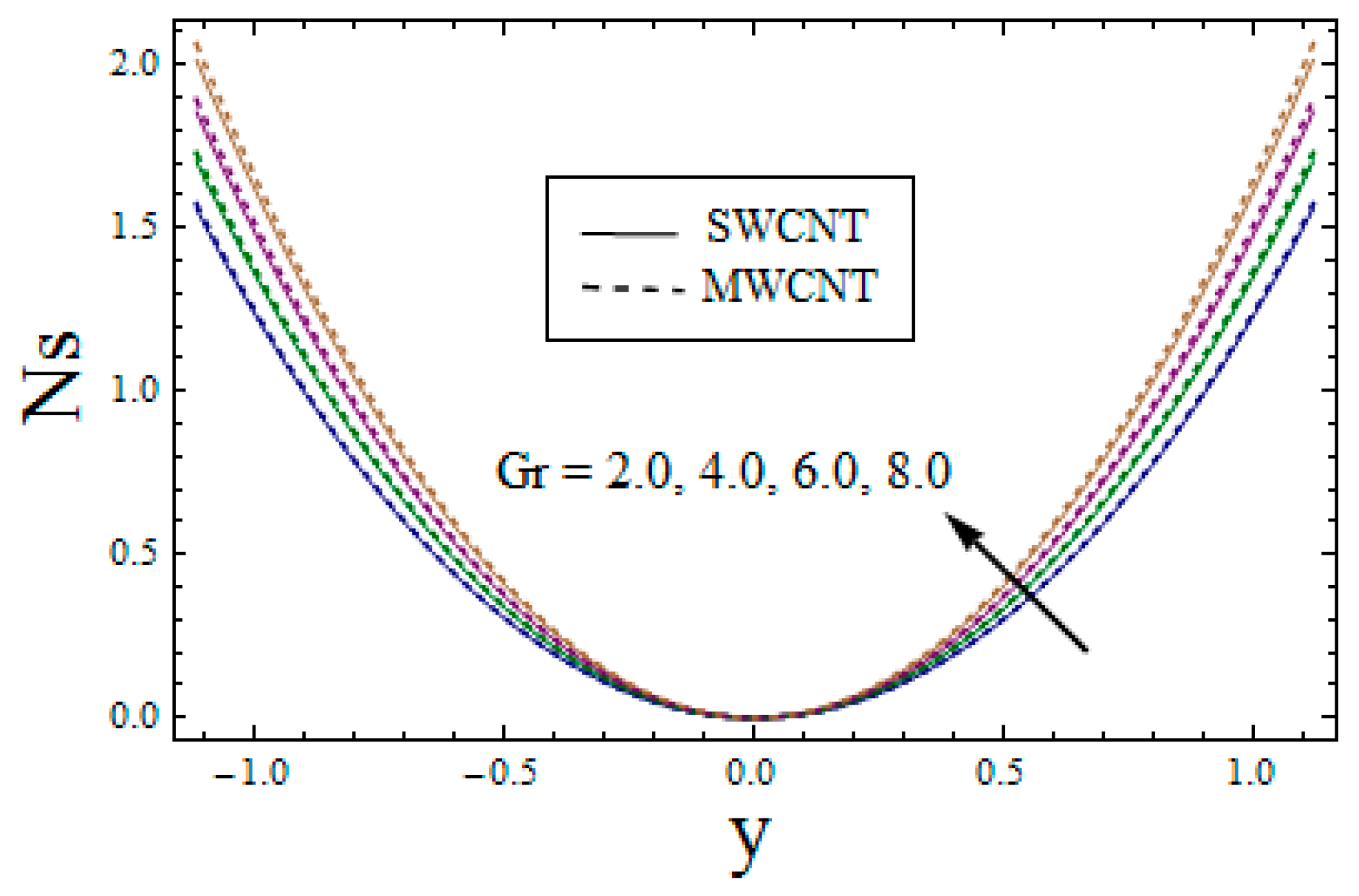

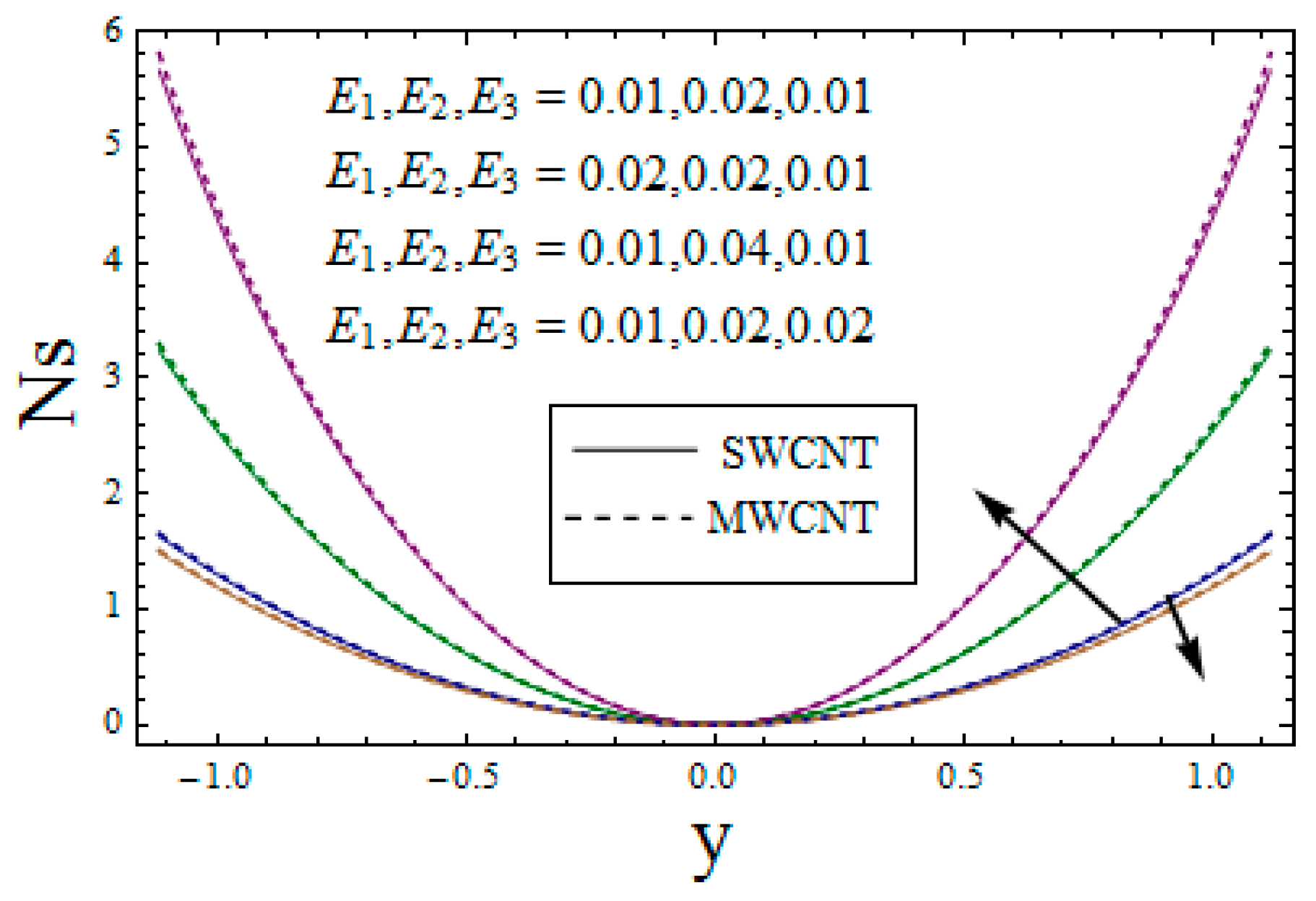


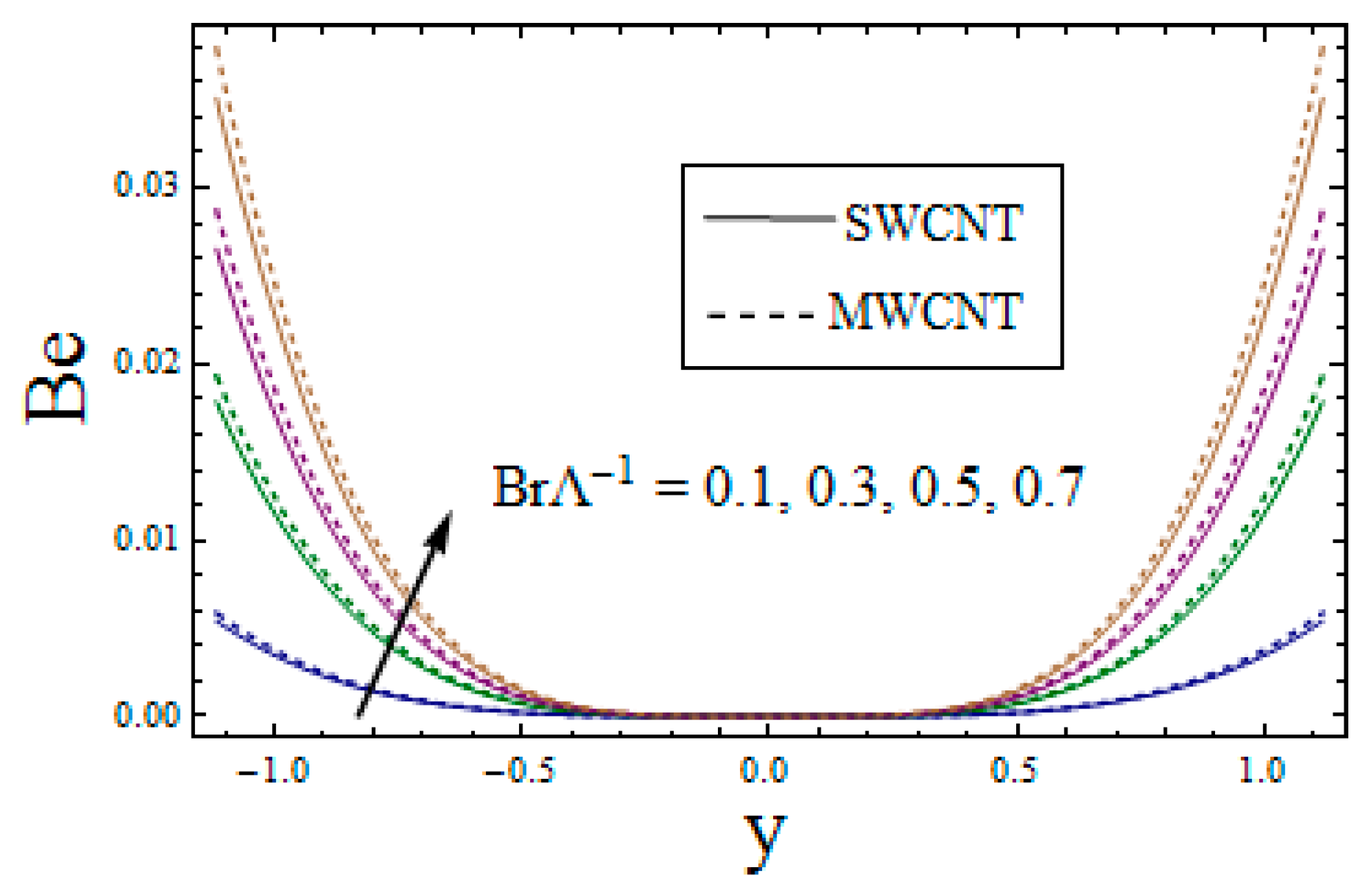
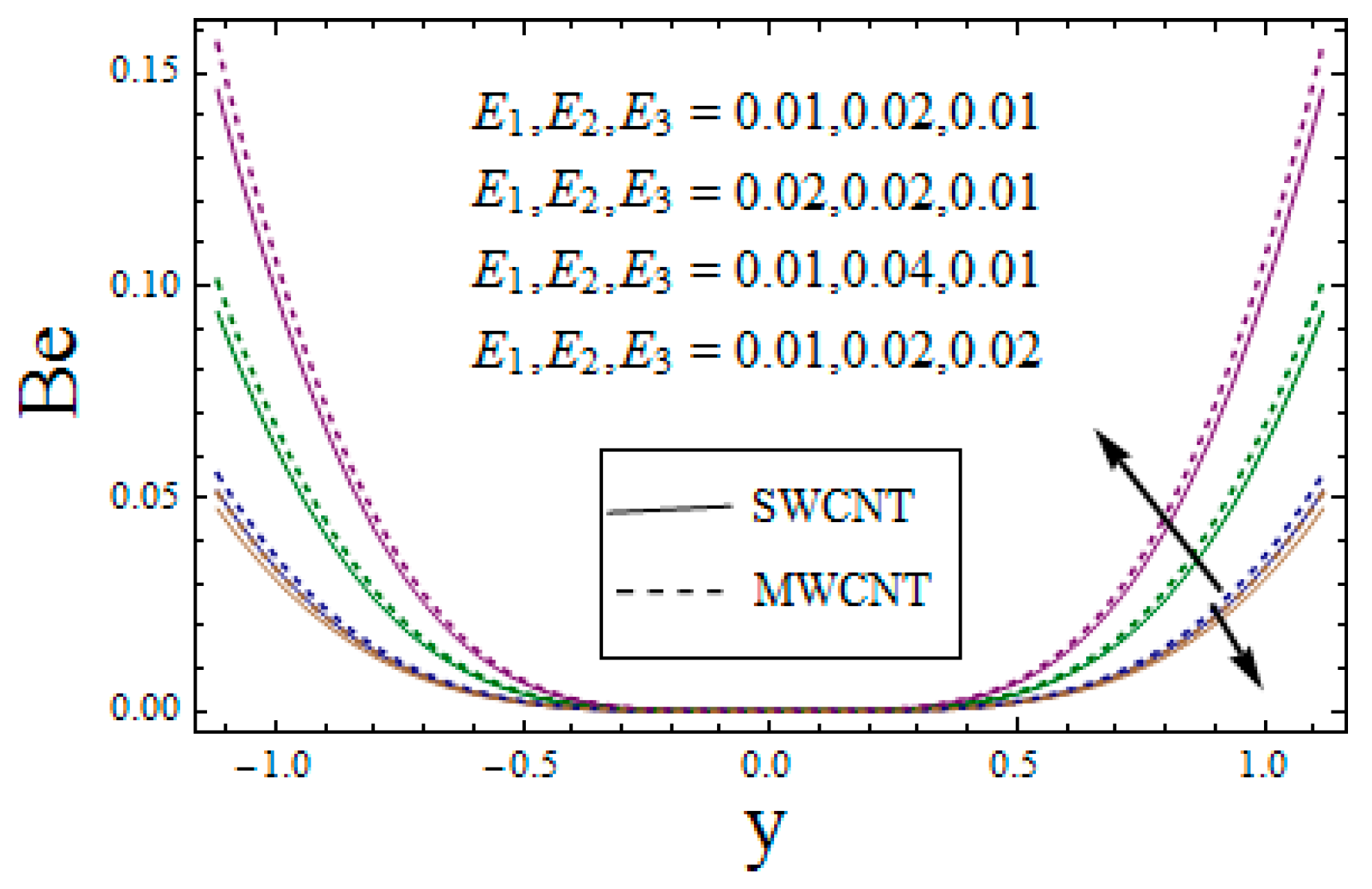

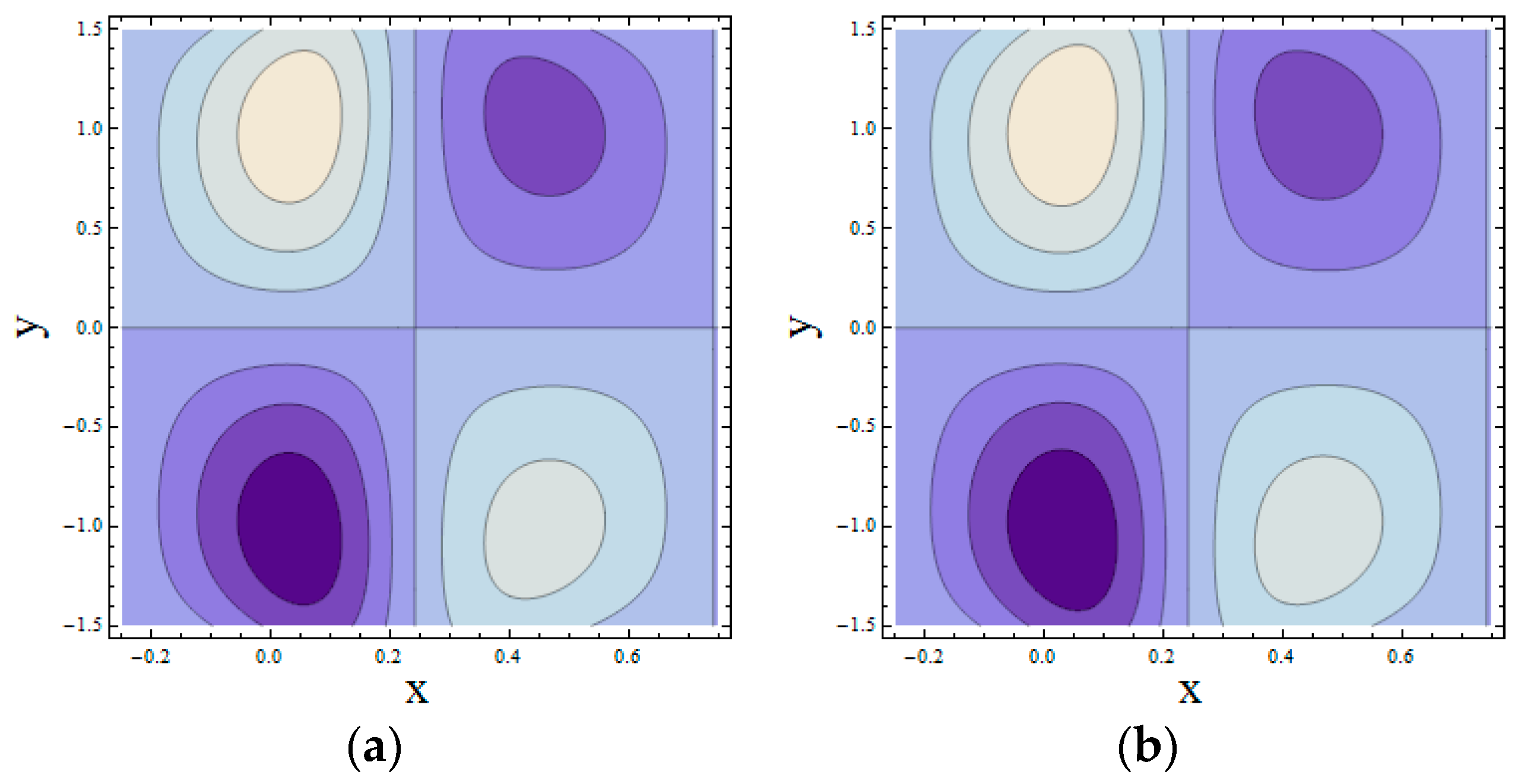
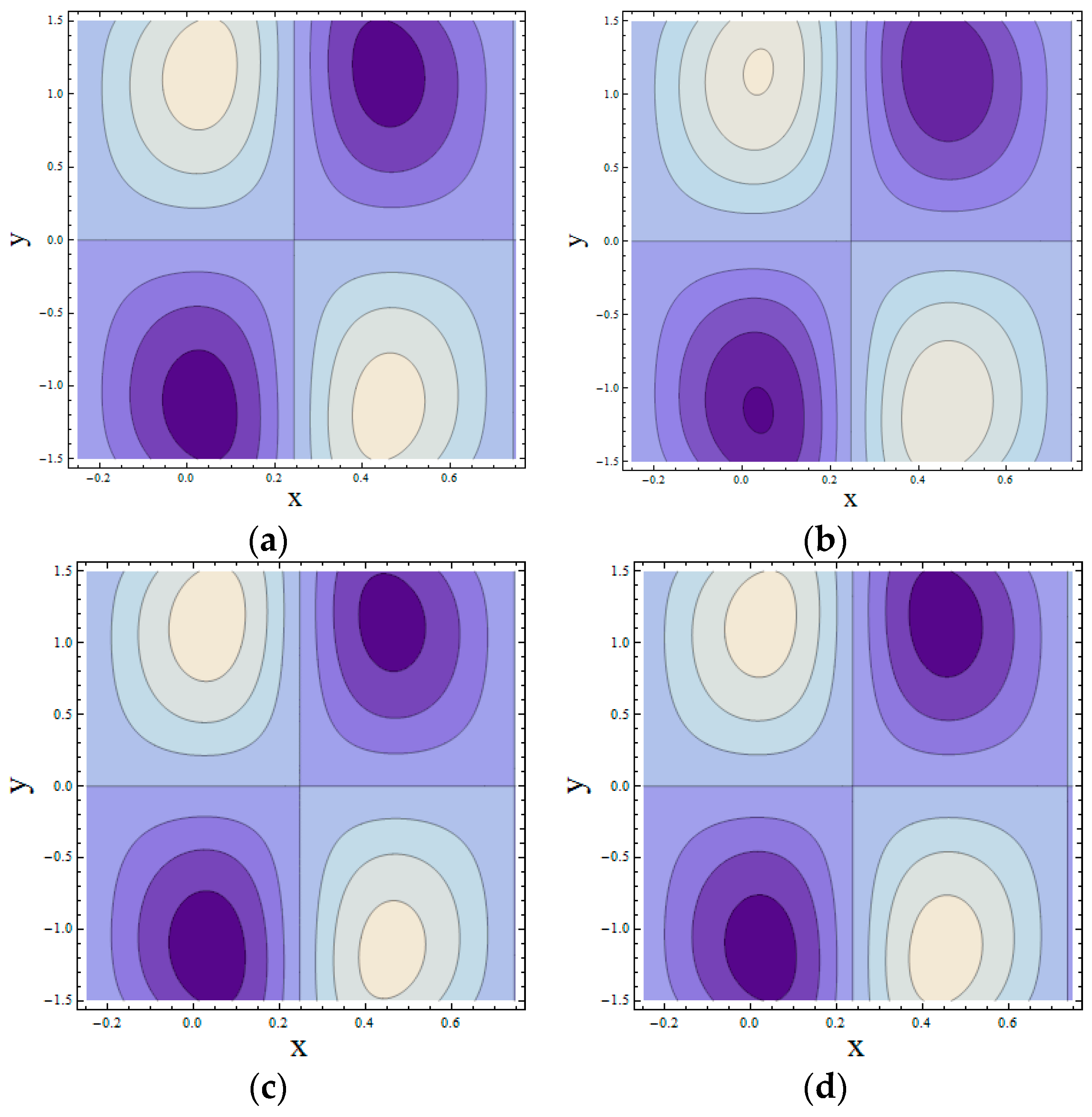
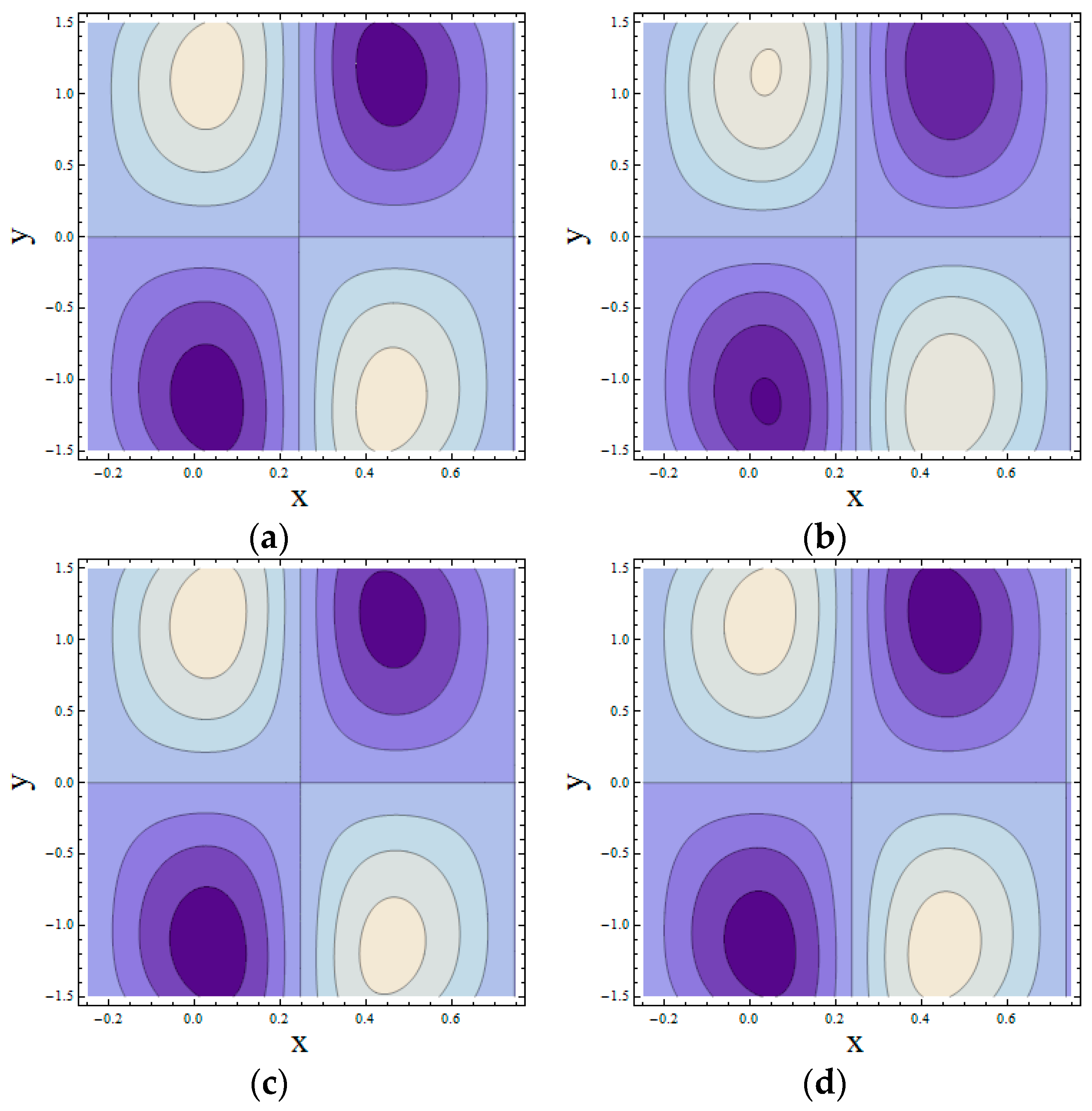
© 2016 by the authors; licensee MDPI, Basel, Switzerland. This article is an open access article distributed under the terms and conditions of the Creative Commons Attribution (CC-BY) license (http://creativecommons.org/licenses/by/4.0/).
Share and Cite
Hayat, T.; Nawaz, S.; Alsaedi, A.; Rafiq, M. Analysis of Entropy Generation in Mixed Convective Peristaltic Flow of Nanofluid. Entropy 2016, 18, 355. https://doi.org/10.3390/e18100355
Hayat T, Nawaz S, Alsaedi A, Rafiq M. Analysis of Entropy Generation in Mixed Convective Peristaltic Flow of Nanofluid. Entropy. 2016; 18(10):355. https://doi.org/10.3390/e18100355
Chicago/Turabian StyleHayat, Tasawar, Sadaf Nawaz, Ahmed Alsaedi, and Maimona Rafiq. 2016. "Analysis of Entropy Generation in Mixed Convective Peristaltic Flow of Nanofluid" Entropy 18, no. 10: 355. https://doi.org/10.3390/e18100355





